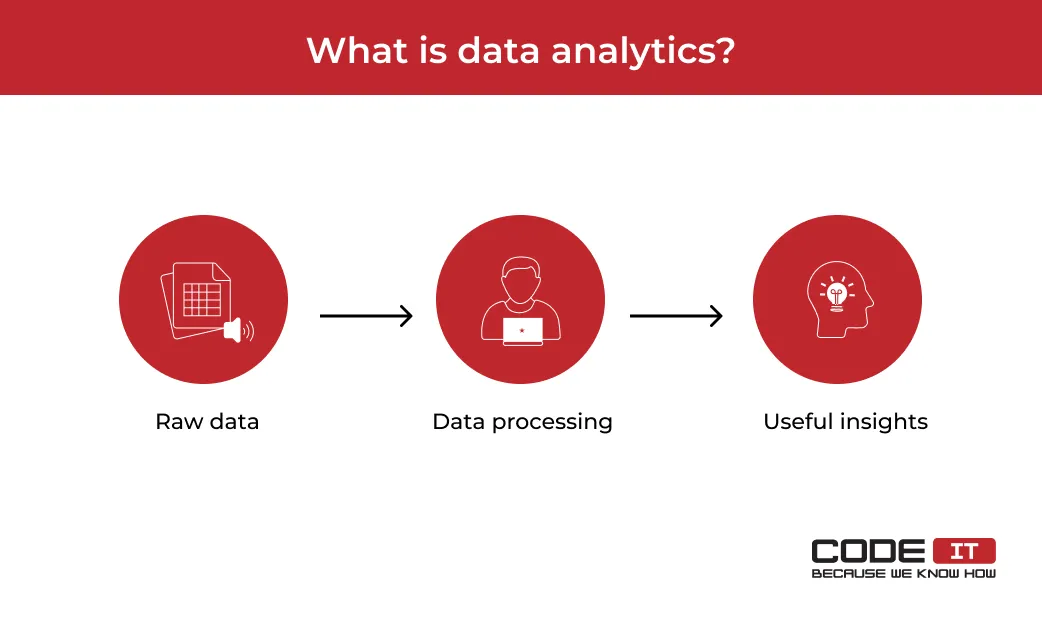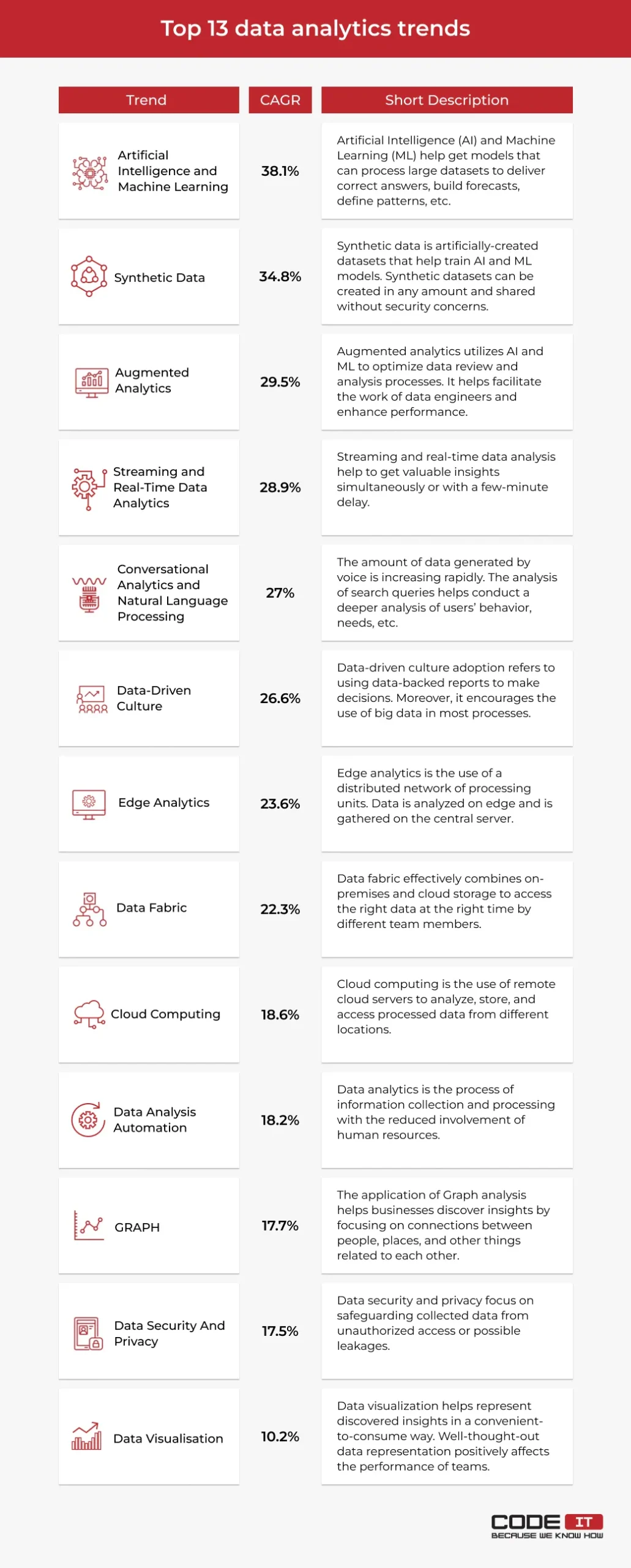Latest trends in data analytics to watch out in 2025


The amount of data produced grows exponentially. According to Statista, the global data volume will reach 181 zettabytes milestone in 2025.
For instance, billions of IoT devices generate vast volumes of raw data that can be turned into valuable insights if analyzed. With the help of data analytics, businesses can use gathered information to discover customers’ behavior patterns, forecast trends, spot mistakes, etc.

Therefore, data and analytics have been continuously realized as crucial in companies for enhancing business efficiency over the years.
The goal is to turn data into information and information into insight.
Many different approaches and technologies are applied to turn raw data into useful information. In the post below, we will explore the top 13 data analytics trends arranged by their compound annual growth rate (CAGR).

1. Artificial Intelligence And Machine Learning
The AI and ML implementation foresees the opportunity to build and train models that can consume large amounts of data and deliver useful insights. Well-trained models can analyze different factors to deliver accurate forecasts, spot patterns, answer questions, etc.
If you find yourself thinking about trends in data analytics, then the first thing you recall is top-tier technologies. Artificial Intelligence (AI) and Machine Learning (ML) play an essential role in the growth of different businesses across various industries.
The increased usage of commercial AI and ML will help in the accelerated deployment of models in production, driving more value to businesses and investments. These days, open-source solutions dominate the AI and ML sectors.
However, the commercial application of the technologies will help develop more scalable solutions for project management, model management, data reuse, transparency, and lineage.
2. Synthetic Data
Synthetic data is a type of information that is generated artificially. The fast-paced development of Artificial Intelligence and Machine Learning drives other trends in data analytics to grow fast as well.
Simulations replace real-world events to collect large sets of synthetic data.
Even though the global data volume grows exponentially, some businesses experience a shortage of data to train models. The larger datasets are used for models’ training, the more accurate forecasts and answers they will deliver.
Moreover, artificially-created datasets have significant advantages over real-world data. The top three are:
- Increased data quality. The quality of datasets used to train models affects the quality of their outputs. Synthetic data is generated by computers, following defined rules. Moreover, it may imply more details to help train models effectively.
- Fever security concerns. Real data collected by a business should be treated with security in mind. However, artificially-collected information can be collected, shared, and erased without any security concerns.
- Easy to collect. Unlike real-world data, synthetic datasets can be easily generated in different amounts without any limitations.
The global synthetic data generation market is expected to grow fast, with a 34.8% compound annual growth rate (CAGR). Gartner predicts that by 2024 roughly 60% of all the data used to train AI and ML models will be generated artificially.
3. Augmented Analytics
Using Machine Learning and Artificial Intelligence, augmented analytics amplifies data processing and sharing with an ability to automate various important analytics tasks like preparation, analysis, and creation of accurate models.
The augmented analytics market share was valued at $10.06 billion in 2021 and is projected to reach $103.87 billion with a CAGR of 29.5% in 2030. Hence, it is one of the fastest-growing data analytics trends.
Augmented analytics plays an important part in empowering more individuals in an organization to pick up business insights from data without the need to use complex mathematics or computer science.
With the help of custom software solutions, it will be easier for business owners to create a simplified and more approachable way of building analytics models. Also, the approach helps enhance data analysis performance.
4. Streaming And Real-time Data Analytics
Real-time data analytics is the process of exploring recently-collected information. Results of data analysis are usually provided within several seconds or minutes after receiving a query.
Streaming data analytics is the continuous data analysis process. It is usually applied to small datasets that can be rapidly analyzed without consuming many resources.
The application of streaming and real-time data analytics helps get access to valuable insights or users’ behavior patterns instantly. Hence, businesses can effectively offer more suitable offers or suggest products to customers.
With data collection, ‘the sooner, the better’ is always the best answer.
5. Conversational Analytics And Natural Language Processing
Voice-enabled devices have become popular in different companies and businesses due to their ease of use in the interaction of clients and businesses. According to Statista, the number of voice-enabled devices worldwide will surpass the 8-billion milestone in 2025.
This technology will continue to rise as one of the main trends in data analytics as it provides integrated voice tools, and companies realize that conversational analytics brings considerable benefits that are:
- sentiment analysis
- enhanced social listening
- personalization
These factors are a huge assistance in the usage of chatbots and other conversational-based interfaces. Aside from that, insights are better delivered through conversational analytics simply by conversing with data through AI-driven combinations of natural language processing (NLP) and natural language generation (NLG).
The NLP market is estimated to grow continuously with a 27% CAGR. Hence, a lot of businesses adopt the technology to discover helpful insights by exploring voice search queries.
6. Data-driven Culture
The data-driven culture describes the data-driven decision-making approach. Product owners and decision makers consider using data analysis reports to make decisions instead of using personal experience or other factors.
Incorporating data-driven culture into the whole organization in 2025 will be one of the priorities of business intelligence (BI) professionals and business managers. Data is very important when it comes to making decisions in the business.
Thus, data culture implementation can be beneficial as employees are more empowered. They need data to be more accessible within market segmentations. Harvard Business Review states that decision-making processes will be sped up because of the data-driven culture’s ability to easily examine and organize data.
7. Edge Analytics
Edge analytics is the process of using a scattered network of computing units that help analyze data out of the main server. The edge analytics market is estimated to grow with a 23.6% CAGR, making data analysis on edge one of the data analytics trends in 2025.
The main benefits of using a decentralized data processing approach are:
- effective resources usage
- faster data processing
- fewer data transferred over a network
- fewer data is stored and processed by the central server
- easy to scale up by adding new edge nodes
Edge analytics is widely used in Internet of Things (IoT) systems. Devices or distributed edge nodes process large amounts of raw data. Hence, only valuable business insights or condensed data are transferred to the central server.
8. Data Fabric
With companies expanding, having more data can become challenging in terms of processing, management, analysis, and storage. Hence, data fabric is fundamental, enabling applications and different tools to access data.
With data fabric, businesses can simplify their data management process across on-premises and cloud environments, thus making the transition to digital transformation easier.
Data fabric adoption has become one of the top data analytics trends due to its capabilities to enable data sharing in a distributed data environment seamlessly. Fortune Business Insights forecasts the continuous data fabric market growth with a 22.3% CAGR.
9. Cloud Computing
Cloud computing is the process of using cloud servers and databases to store and analyze data. Cloud storage can be connected from any location by many users. Moreover, computing power and data storage capacity can be scaled up fast.
The main advantage of cloud computing are:
- efficient resources usage
- enhanced scalability
- improved collaboration
- greater security and reliability
According to GlobeNewswire, the cloud computing market will keep flourishing with an 18.6% CAGR.
Hire us to build a cloud-based data analytics platform!

Business First
Code Next
Let’s talk
10. Data Analysis Automation
Over the years, big data has been collected, stored, and processed. The continuous growth prompts business organizations and companies to incorporate automation to handle massive data information.
Business intelligence has always provided solutions for consolidating all the data and providing different methods to discover, analyze, measure, monitor, and evaluate data. Automation helps reduce the involvement of human resources to analyze data and make decisions.
Software business analysis will continue to be one of the top trends in data analytics and bring automation possibilities for more accessible data collection, analysis, monitoring, and reporting using big data analytics software.
With automation, businesses can simplify the tasks assigned to data scientists. It is supposed to improve the speed of developing advanced analytics.
11. Graph
Graph analytics is a set of analytic techniques providing necessary information regarding the connection of people, places, things, and their relationships.
Graph technology is helpful in various industry verticals to cope with fraud detection, traffic route optimization, social network analysis, genome research, etc.
Graph empowers the connection and knowledge of different technologies through data. One example of merging data are fitness applications connected to health news feeds.
12. Data Security And Privacy
Data breaches, poor authentication practices, and compromised sensitive data are the most widespread security threats. According to the report prepared by Statista, the money loss caused by cyber crimes grows by 50% annually, on average.
Therefore, businesses actively adopt data security and privacy practices to safeguard personal data. The three most popular practices that help keep big data safe are:Data minimization. Data that implies personal information isn’t collected to eliminate privacy risks.
Data de-identification. Datasets are reviewed and updated to remove any strings that imply personal information.
User access control. Processes that limit access to datasets for unauthorized users.
13. Data Visualization
The foremost trends in data analytics are focused on turning useful data into business insights. However, large amounts of data-driven insights should be conveniently delivered to end users.
Data visualization aims to present information in a convenient-to-consume way to bridge the gap between datasets and words. The most widespread visual representation elements are:
- charts
- maps
- graphs
- tables
All the information should be arranged to deliver the most valuable information to end users. Custom dashboards are one of the top data visualization features. They help provide the most critical insights to different users, depending on their needs and requirements.
GlobeNewswire estimates the global data visualization market to grow constantly with a 10.15% CAGR.
In Conclusion
In 2025, data and analytics will be a part of business intelligence’s rapid growth and development. The top 13 trends in data analysis are:
- Artificial Intelligence and Machine Learning — CAGR 38.1%
- Synthetic data — CAGR 34.8%
- Augmented analytics — CAGR 29.5%
- Streaming and real-time data — CAGR 28.9%
- Conversational analytics and natural language processing — CAGR 27%
- Data-driven culture — CAGR 26.6%
- Edge analytics — CAGR 23.6%
- Data fabric — CAGR 22.3%
- Cloud computing — CAGR 18.6%
- Data analysis automation — CAGR 18.2%
- Graph — CAGR 17.7%
- Data security and privacy — CAGR 17.5%
- Data visualization — CAGR 10.2%
Big corporations and various industries have observed data analytics as an important source for making more informed decisions in recruitment, marketing, and branding. It is also expected inventory, supply chains, fraud, and risk management companies to utilize complex data for a more sophisticated and accurate prediction in 2025.
With fast-paced technological advancement, it’s smart to stake in top data analytics trends in 2025 to keep your business ahead of the game toward a more competitive future.
Suppose you are thinking of incorporating these trends in your app development. In that case, you will need expert opinions and consultations from specialists from a reliable software development company with a strong project background and portfolio.
FAQ
The fastest-growing data science trends in 2024 are:
- Artificial Intelligence and Machine Learning
- Synthetic data
- Augmented analytics
- Streaming and real-time data
- Conversational analytics
- Data-driven culture
- Edge analytics
- Data fabric
- Cloud computing
- Data analysis automation
- Graph
- Data security and privacy
- Data visualization
The five fastest-growing data analytics future trends are listed below and sorted by the compound annual growth rate (CAGR).
Artificial Intelligence and Machine Learning — CAGR 38.1%
Synthetic data — CAGR 34.8%
Augmented analytics — CAGR 29.5%
Streaming and real-time data — CAGR 28.9%
Conversational analytics — CAGR 27%
In short, the future of data analytics is:
- data-rich
- AI- and ML-enabled
- real-time
- automated
According to the latest trends in data analytics for business organizations, the data-driven future will need businesses to adopt AI and ML to process large amounts of information effectively.
Due to the extensive volume of data needed to be processed, data analysis automation tools and processes are developed at a high pace.
Striving to get the most valuable insights as fast as possible, businesses will actively adopt solutions to process streaming and live-time data.
Build your ideal
software today





